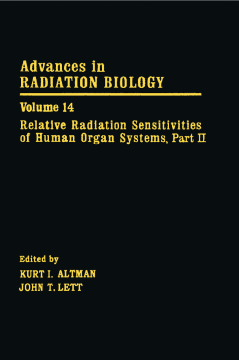
Additional Information
Book Details
Abstract
Advances in Radiation Biology, Volume 14: Relative Radiation Sensitivities of Human Organ Systems, Part II focuses on radiation sensitivities of particular human organ systems. The sensitivities are then assessed based on the severity and the rapidity in which the effects of radiation manifest.
The opening chapter surveys the clinical and experimental data on approaches toward the prevention of bladder complications in clinical radiotherapy. A discussion on HeLa cells, which are of special importance in human cervical cancer therapy, is then presented. In presenting this topic, this book emphasizes radiation sensitivity and radiobiology of tumors of the cervix of the female genital tract. Chapter 3 briefly covers imaging techniques for hypothalamic-pituitary dysfunction diagnosis and introduces hormonal therapy for remarkable improvements in both physical and mental status of patients. The subsequent chapters discuss basic radiobiology of the thyroid in experimental animal and the late effects of therapeutic and low-level radiation in humans. The radiation damages in bone and cartilage and the changes occurring in the various types of vessels during radiation therapy are also discussed.
Chapter 7 presents the basic biology of spermatogenesis, as it applies to the understanding of radiation effects. This chapter also explains the studies of rodents, as it applies to subhuman primates and to man. Moreover, it considers as well the mechanisms of radiation damage to the testis, as elucidated by experimental studies of rodents and subhuman primates. Finally, it presents the limited data available on man and discusses these data in terms of the biology of the system known from experimental studies. The concluding chapter describes the features of radiation-induced hepatic injury, ranging from asymptomatic biochemical or a radiographic abnormality to fulminant, fatal hepatic failure.
Radiation biologists will greatly benefit from this book, especially those who are involved in dose fractionation in radiation therapy.
